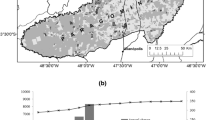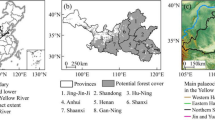Abstract
Understanding drivers of forest-cover change is essential for a broad range of ecosystem properties. In this work, we assessed changes in forest cover using physical, climatic and socio-economic drivers, including forest neighbourhood effects representing spatial interactions within and between two time periods (1880–1940; 1940–2010), for a mountainous study area located in eastern Switzerland. The robust assessment relied on an ensemble modelling approach that combined projections of six statistical models (GAM, CART, ANN, RF, GBM, GLM). A generic neighbourhood variable (distance to forest edge) explained most of the forest-cover change (variable importance of >90%) for both forest gain and loss, whereas socio-economic, physical and climatic variables were of least importance. The performance of models of forest loss was consistently higher and less varied (TSS of model ensembles 0.65–0.82) compared to models of forest gain (TSS of model ensembles 0.2–0.62) independent of the time period considered. We concluded that (a) the relative importance of drivers for the simulated processes is independent of the time period considered; (b) ensemble modelling proves a powerful tool to assess projection robustness by considering a suite of models rather than a single model type and (c) the inclusion of generic neighbourhood variables such as distance to forest edge improves model performance significantly.







Similar content being viewed by others
References
Aggemyr E, Cousins SAO (2009) Landscape structure and land use history influence changes in island plant composition after 100 years. J Biogeogr 39:1645–1656
Allouche O, Tsoar A, Kadmon R (2006) Assessing the accuracy of species distribution models: prevalence, kappa and the true skill statistic (TSS). J Appl Ecol 43:1223–1232. doi:10.1111/j.1365-2664.2006.01214.x
Ameztegui A, Coll L, Brotons L, Ninot JM (2016) Land-use legacies rather than climate change are driving the recent upward shift of the mountain tree line in the Pyrenees. Glob Ecol Biogeogr 25:263–273. doi:10.1111/geb.12407
Anandhi A, Frei A, Pierson DC, Schneiderman EM, Zion MS, Lounsbury D, Matonse AH (2011) Examination of change factor methodologies for climate change impact assessment. Water Resour Res 47:W03501. doi:10.1029/2010WR009104
Araujo MB, New M (2007) Ensemble forecasting of species distributions. Trends Ecol Evol 22:42–47. doi:10.1016/j.tree.2006.09.010
Bellassen V, Viovy N, Luyssaert S, le Maire G, Schelhaas M, Ciais P (2011) Reconstruction and attribution the carbon sink of European forests between 1950 and 2000. Glob Chance Biol 17:3274–3292. doi:10.1111/j.1365-2486.2011.02476.x
Bolliger J, Schulte LA, Burrows SN, Sickley TA, Mladenoff DJ (2004) Assessing restoration potentials of Wisconsin (USA) using historical landscape reconstructions. Restor Ecol 12:124–142
Breiman L (2001) Random forests. Mach Learn 45:5–32
Breiman L, Friedman J, Olshen R, Stone C (1984) Classification and regression trees. Wadsworth, New York
Bundesamt für Statistik (2015) Statistisches Lexikon der Schweiz. Historic collection. http://www.bfs.admin.ch/bfs/portal/de/index/infothek/lexikon/lex/2
Callister KE, Griffioen PA, Avitabile SC, Haslem A, Kelly LT, Kenny SA, Nimmo DG, Farnsworth LM, Taylor RS, Watson SJ, Bennett AF, Clarke MF (2016) Historical maps from modern images: using remote sensing to model and map century-long vegetation change in a fire-prone region. PLoS ONE. doi:10.1371/journal.pone.0150808
Congalton RG, Green K (2009) Assessing the accuracy of remotely sensed data: principals and practices, 2nd edn. CRC Press, Taylor and Francis Group, Boca Raton
Dendoncker N, Rounsevell M, Bogaert P (2007) Spatial analysis and modelling of land use distributions in Belgium. Comput Environ Urban Syst 31:188–205. doi:10.1016/j.compenvurbsys.2006.06.004
Engler S, Werner JP (2015) Processes prior and during the early 18th century Irish famines-weather extremes and migration. Climate 3:1035–1056. doi:10.3390/cli3041035
Engler R, Waser LT, Zimmermann NE, Schaub M, Berdos S, Ginzler C, Psomas A (2013) Combining ensemble modeling and remote sensing for mapping individual tree species at high spatial resolution. For Ecol Manag 310:64–73. doi:10.1016/j.foreco.2013.07.059
Freeman EA, Moisen GG (2008) A comparison of the performance of threshold criteria for binary classification in terms of predicted prevalence and kappa. Ecol Model 217:48–58. doi:10.1016/j.ecolmodel.2008.05.015
Fuchs R, Herold M, Verburg PH, Clevers JGPW, Eberle J (2015) Gross changes in reconstructions of historic land cover/use for Europe between 1900 and 2010. Glob Change Biol 21:299–313. doi:10.1111/gcb.12714
Gellrich M, Baur P, Zimmermann N (2007) Natural forest regrowth as a proxy variable for agricultural land abandonment in the Swiss mountains: a spatial statistical model based on geophysical and socio-economic variables. Environ Model Assess 12:269–278. doi:10.1007/s10666-006-9062-6
Ginzler C, Brändli UB, Hägeli M (2011) Waldflächenentwicklung der letzten 120 Jahre in der Schweiz. Schweizerische Zeitschrift für Forstwesen 162:337–343
Gold S, Korotkov A, Sasse V (2006) The development of European forest resources, 1950 to 2000. For Policy Econ 8:183–192
Haase D, Walz U, Neubert M, Rosenberg M (2007) Changes to Central European landscapes—analysing historical maps to approach current environmental issues, examples from Saxony, Central Germany. Land Use Policy 24:248–263. doi:10.1016/j.landusepol.2005.09.003
Hastie T, Tibshirani R (1986) Generalized additive models. Stat Sci 1:297–318
Kaim D, Kozak J, Ostafin K, Dobosz M, Ostapowicz K, Kolecka N, Gimmi U (2014) Uncertainty in historical land-use reconstructions with topographic maps. Quaest Geogr 33:57–63. doi:10.2478/quageo-2014-0029
Kulakowski D, Bebi P, Rixen C (2011) The interacting effects of land use change, climate change and suppression of natural disturbances on landscape forest structure in the Swiss Alps. Oikos 120:216–225. doi:10.1111/j.1600-0706.2010.18726.x
Lambin E, Meyfroidt P (2011) Global land use, economic globalization, and the looming land scarcity. Proc Natl Acad Sci USA 108:3465–3472. doi:10.1073/pnas.1100480108
Lambin EF, Turner BL, Geist HJ, Agbola SB, Angelsen A, Bruce JW, Coomes O, Dirzo R, Fischer G, Folke C, George PS, Homewood K, Imbernon J, Leemans R, Li X, Moran EF, Morimore M, Ramakrishnan PS, Richards JF, Skanes H, Steffen WL, Stone GD, Svedin U, Veldkamp TA, Vogel C, Xu J (2001) The causes of land use and land-cover change: moving beyond the myths. Glob Environ Change 11:261–269. doi:10.1016/S0959-3780(01)00007-3
Leyk S, Boesch R, Weibel R (2006) Saliency and semantic processing: extracting forest cover from historical topographic maps. Pattern Recogn 39:953–968. doi:10.1016/j.patcog.2005.10.018
Loran C, Ginzler C, Bürgi M (2016) Evaluating forest transition based on a multi-scale approach: forest area dynamics in Switzerland 1850–2000. Reg Environ Change. doi:10.1007/s10113-015-0911-1
Loran C, Munteanu C, Verburg P, Schmatz DR, Bürgi M, Zimmermann NE (in press) Long-term change in drivers of forest cover dynamics: an analysis for Switzerland (1850–2000). Reg Environ Change
Luterbacher J, Dietrich D, Xoplaki E, Grosjean M, Wanner H (2004) European seasonal and annual temperature variability, trends, and extremes since 1500. Science 303:1499–1503. doi:10.1126/science.1093877
Magliocca NR, Rudel TK, Verburg PH, McConneell WJ, Mertz O, Gerstner K, Heinimann A, Ellis EC (2015) Synthesis and land change science: methodological patterns, challenges, and guidelines. Reg Environ Change 15:211–226. doi:10.1007/s10113-014-0626-8
Marmion M, Parviainen M, Luoto M, Heikkinen RK, Thuiller W (2009) Evaluation of consensus methods in predictive species distribution modelling. Divers Distrib 15:59–69. doi:10.1111/j.1472-4642.2008.00491.x
McCullagh P, Nelder JA (1989) Generalized linear models, 2nd edn. Chapman and Hall, London
Pauling AJ, Luterbacher C, Casty H, Wanner H (2006) Five hundred years of gridded high-resolution precipitation reconstructions over Europe and the connection to large-scale circulation. Clim Dyn 26:387–405. doi:10.1007/s00382-005-0090-8
Pazur R, Lieskovsky J, Fernanec J, Othael J (2014) Spatial determinants of abandonment of large-scale arable lands and managed grasslands in Slovakia during the periods of post-socialist transition and European Union accession. Appl Geogr 54:118–128. doi:10.1016/j.apgeog.2014.07.014
Regos A, D’Amen M, Titeux N, Herrando S, Guisan A, Bortons L (2016) Predicting the future effectiveness of protected areas for bird conservation in Mediterranean ecosystems under climate change and noel fire regime scenarios. Divers Distrib 22:83–96. doi:10.1111/ddi.12375
Rickebusch S, Gellrich M, Lischke H, Guisan A, Zimmermann NE (2007) Combining probabilistic land-use change and tree population dynamics modelling to simulate responses in mountain forests. Ecol Model 209:157–168. doi:10.1016/j.ecolmodel.2007.06.027
Ridgeway G (1999) The state of boosting. Comput Sci Stat 31:172–181
Riley SJ, DeGloria SD, Elliot R (1999) A terrain ruggedness index that quantifies topographic heterogeneity. Intermt J Sci 5:23–27
Ripley BD (1996) Pattern recognition and neural networks. Cambridge University Press, Cambridge. ISBN 0 521 46086 7
Rounsevell MDA, Pedroli B, Erb KH, Gramberger M, Busck AG, Haberl H, Kristensen S, Kuemmerle T, Lavorel S, Lindner M, Lotze-Campen H, Metzger MJ, Murray-Rust D, Popp A, Perez-Soba M, Reenberg A, Vadineanu A, Verburg PH, Wolfslehner B (2012) Challenges for land system science. Land Use Policy 29:899–910. doi:10.1016/j.landusepol.2012.01.007
Scales KL, Miller PI, Ingram SN, Hazen EL, Bograd SJ, Phillips RA (2016) Identifying predictable foraging habitats for a wide-ranging marine predator using ensemble ecological niche models. Divers Distrib 22:212–224. doi:10.1111/ddi.12389
SFSO, Swiss Federal Statistical Office (2013) Land use in Switzerland: Results of the Swiss land use statistics. SFSO, Neuchatel
Siegfriedkarten (1870–1922) Siegfriedkarten. In: Schweizerische Landestopographie. http://www.swisstopo.ch/de/maps/ak/tk.htm
swissTLM3D (2015) Vectorized national map 1:25,000. Bundesamt für Landestopographie. http://www.swisstopo.admin.ch. Wabern, Bern
Swisstopo (2016) Vektor 25. Bundesamt für Landestopographie. http://www.swisstopo.admin.ch. Wabern, Bern
Thornton PE, Running SW, White MA (1997) Generating surfaces of daily meteorological variables over large regions of complex terrain. J Hydrol 190:214–251. doi:10.1016/S0022-1694(96)03128-9
Thuiller W, Lafourcade B, Engerl R, Araujo MB (2009) BIOMOD—a platform for ensembel forecasting of species distributions. Ecography 32:369–373. doi:10.1111/j.1600-0587.2008.05742.x
Van Asselen S, Verburg PH (2013) Land cover change or land-use intensification: simulating land system change with a global-scale land change model. Glob Change Biol 19:3648–3667. doi:10.1111/gcb.12331
Vilén T, Cienciala E, Schelhaas MJ, Verkerk PJ, Lindner M, Peltola H (2015) Increasing carbon sinks in European forests: effects of afforestation and changes in mean growing stock volume. Forestry. doi:10.1093/forestry/cpv034
Wang Q, Ren QF, Liu JF (2016) Identification and apportionment of the drivers of land use change on a regional scale: unbiased recursive partitioning-based stochastic model application. Agric Ecosyst Environ 217:99–110. doi:10.1016/j.agee.2015.11.004
Weisberg PJ, Shandra O, Becker ME (2013) Landscape influences on recent timberline shifts in the Carpathian mountains: abiotic influences modulate effects of land-use change. Arct Antarct Alp Res 45:404–414. doi:10.1657/1938-4246-45.3.404
Wilson MFJ, O’Connell B, Brown C, Guinan JC, Grehan AJ (2007) Multiscale terrain analysis of multibeam bathymetry data for habitat mapping on the continental slope. Mar Geod 30:3–35. doi:10.1080/01490410701295962
Xoplaki E, Luterbacher J, Paeth H, Dietrich D, Steiner N, Grosjean M, Wanner H (2005) European spring and autumn temperature variability and change of extremes over the last half millennium. Geophys Res Lett 32:L15713. doi:10.1029/2005GL023424
Acknowledgements
We thank Niklaus E. Zimmermann, the Editors of REEC and two reviewers for valuable input on earlier drafts of this manuscript. Many thanks go also to Bronwyn Price who carefully improved our English. Samuel Berger and Marc Herrmann carefully collated the socio-economic data. This research financed by the FORECOM project (forest-cover changes in mountainous regions—drivers, trajectories, implications, PSRP008/2010), supported by Grant from Switzerland through the Swiss contribution to the enlarged European Union.
Author information
Authors and Affiliations
Corresponding author
Additional information
Janine Bolliger and Achilleas Psomas have contributed equally to this paper.
Electronic supplementary material
Below is the link to the electronic supplementary material.
Rights and permissions
About this article
Cite this article
Bolliger, J., Schmatz, D., Pazúr, R. et al. Reconstructing forest-cover change in the Swiss Alps between 1880 and 2010 using ensemble modelling. Reg Environ Change 17, 2265–2277 (2017). https://doi.org/10.1007/s10113-016-1090-4
Received:
Accepted:
Published:
Issue Date:
DOI: https://doi.org/10.1007/s10113-016-1090-4




